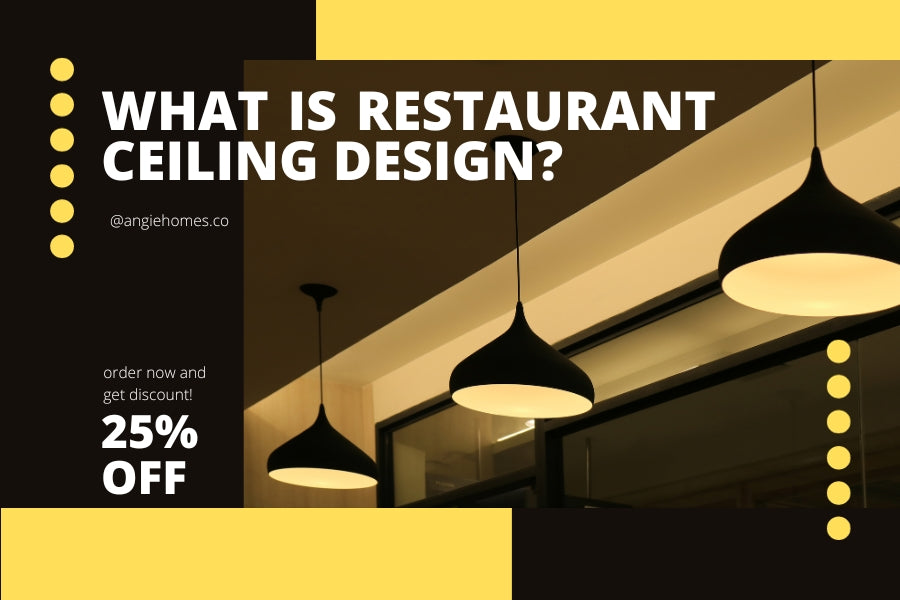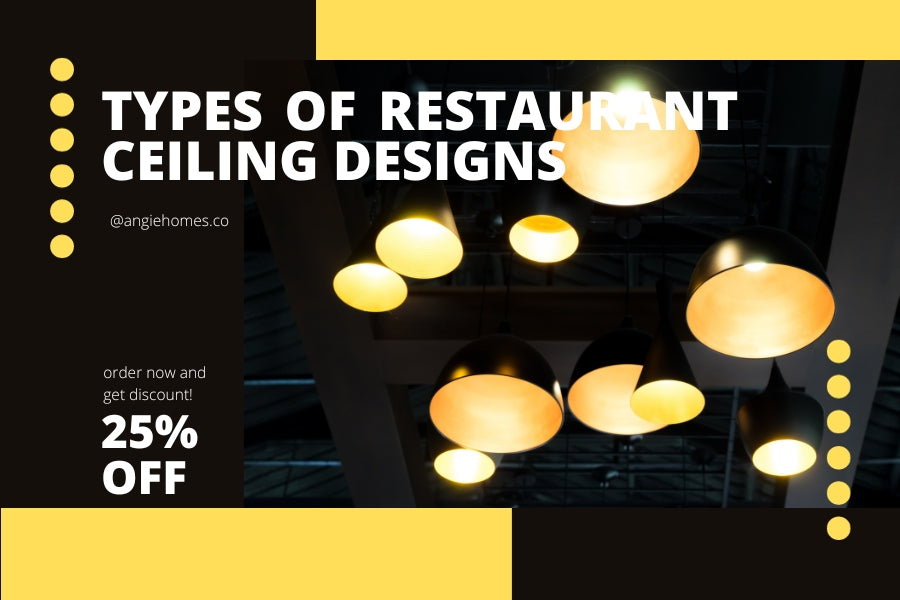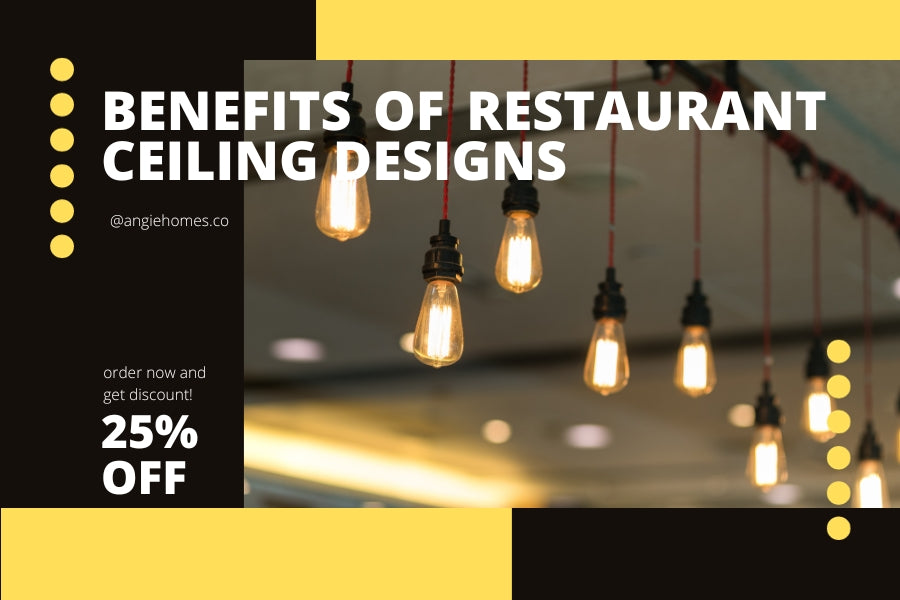Introduction
In the competitive world of dining, creating a memorable experience goes beyond the culinary delights; it extends to the ambiance and aesthetics of the space. One often overlooked aspect of restaurant design that plays a crucial role in setting the mood is the ceiling. Restaurant ceiling designs can transform a mundane space into an inviting and attractive dining area. This article explores the various types of restaurant ceiling designs, their benefits, and specific examples of attractive false ceiling designs that can elevate the overall dining experience.
What Is Restaurant Ceiling Design?

Restaurant ceiling design involves the careful consideration of the architectural elements above diners' heads. From materials and textures to lighting and spatial arrangements, every aspect contributes to the overall atmosphere of the restaurant. Thoughtful ceiling design can enhance the theme, style, and mood of the dining space, creating a cohesive and visually appealing environment.
Types of Restaurant Ceiling Designs

-
Net Tray Restaurant Ceiling Design
One captivating option for restaurant ceilings is the net tray design. This open, grid-like structure adds a touch of modernity and depth to the space, allowing for creative lighting installations and a sense of airiness.
-
Restaurant Ceiling Design with Chandelier
For a touch of elegance and sophistication, incorporating chandeliers into the ceiling design can be a game-changer. The play of light and shadow creates a warm and inviting atmosphere, making it an excellent choice for upscale dining establishments.
-
Elegant Restaurant Ceiling Design
Elegance can be achieved through various design elements, from intricate moldings to subtle color palettes. An elegant restaurant ceiling design exudes refinement and can be tailored to complement the overall theme of the establishment.
-
Restaurant Decor with a Recessed Restaurant False Ceiling
A recessed false ceiling is a versatile choice that allows for the integration of concealed lighting, creating a cozy and intimate ambiance. This design is particularly effective in highlighting specific areas, such as dining booths or the bar.
-
Cove Lighting for Your Restaurant Ceiling Design
Cove lighting involves hidden light sources that direct light upward, creating a soft, indirect glow. This technique adds a touch of drama to the space and is an excellent choice for creating a relaxed and comfortable dining atmosphere.
Ceilings with vaults are arched or domed in many cases, giving an impression of largeness. Vaulted restaurant ceiling designs are traditionally associated with churches and cathedrals, but they can also fit for restaurant spaces, particularly when these are located in historic or architecturally notable buildings. Moreover, this decision makes the restaurant’s experience dramatic and breathtaking.
-
Wooden Restaurant False Ceiling Design
Wooden ceilings bring warmth and a natural aesthetic to the restaurant. Whether using exposed beams or intricate paneling, a wooden false ceiling design can enhance the rustic charm or modern sophistication of the dining space.
-
Indoor Plants for Restaurant Ceiling Design
Integrating indoor plants into the can bring a breath of fresh air to the space. Hanging planters or green walls create a vibrant and organic atmosphere, connecting diners with nature.
-
Lighting Options for Restaurant Ceiling Design
Choosing the right lighting for the ceiling is crucial in setting the desired mood. Pendant lights, track lighting, and spotlights offer diverse options to create focal points and accentuate specific areas within the restaurant.
-
Contemporary Lighting for a Modern Restaurant False Ceiling Design
For modern and trendy establishments, contemporary lighting fixtures can be used to make a bold statement. Unique shapes, materials, and designs can add a touch of avant-garde flair to the restaurant's aesthetic.
-
Loft-Style Restaurant Ceiling Design
Embracing an industrial and open aesthetic, a loft-style restaurant ceiling design often features exposed pipes, ducts, and structural elements. This design choice is popular in urban and trendy dining spaces, creating a cool and relaxed atmosphere.
-
Fabric Restaurant Ceiling
Soft fabric ceilings can add a sense of luxury and acoustical comfort to the restaurant. With various textures and colors to choose from, fabric ceilings provide a customizable solution for creating a unique ambiance.
-
False Ceiling Projections for Added Boldness
Projection mapping on false ceilings can add an element of surprise and boldness to the dining experience. Dynamic visuals, patterns, or themed projections can transform the space throughout the evening.
-
Layered Tray False Ceilings for Your Restaurant
Layered tray ceilings offer depth and dimension to the restaurant's architecture. By incorporating multiple levels and materials, this design adds visual interest and can be customized to suit the desired theme.
Benefits of Restaurant Ceiling Designs

-
Enhanced Ambiance
The idea of using thoughtful design for the restaurant ceiling designs in order to improve ambience is one of the main benefits. Overhead, the space defines the nature of the place whereby it shapes an emotion or a feeling that people feel within the entire dining area. Exposed ceilings give an industry look or even a simple coffered ceiling can add great charm to its decoration.
-
Brand Identity
A lot goes into giving restaurant ceiling designs, which at times is the deciding factor in building a brand identity for the establishment. In this regard, such may entail the use of different things like exposed wooden beams in case a restaurant has a rustic theme so as to achieve uniformity. Using consistent design elements allows customers to relate to the concept and story of the restaurant.
-
Spatial Definition
Appropriate restaurant ceiling designs help distinguish different dining areas in a restaurant. For example, a tray ceiling above the bar section and another one with coffers for the dining space could be used to make them stand out. Varying the restaurant ceiling designs in various sections of the restaurant will create a feeling of space division as well as function.
-
Improved Acoustics
Managing sound levels in busy restaurants is paramount as customers expect to have an enjoyable time when eating out. Sound absorbing materials for instance acoustic ceilings aid in suppressing the noise levels that make people feel at home. This is especially important for high-end restaurants that consider conversation an essential element in the overall experience of customers.
-
Aesthetic Versatility
Restaurant owners and designers can come up with a variety of designs for their interiors given that there are a number of choices regarding the ceiling design. Be it an exposed ceiling or a coffer for that matter, there are always options available depending on the theme as well as concept of the particular restaurant. Establishments enjoy an advantage of being aesthetically diverse hence standing alone from the competition.
-
Innovative Lighting Opportunities
Consequently, ceilings offer perfect surfaces for ingenious lighting devices. The ceiling also serves as a tool for creating highlights, foci, and desired atmosphere. It can accommodate different types of lightings ranging from pendant lights down to recessive fixtures. The lighting designs themselves are creative and add to the general sense of beauty, influencing how people perceive the space.
-
Ease of Maintenance and Accessibility
While some restaurant ceiling designs, for example suspended ceilings, are more practical in terms of cleaning, ease of access. Easy access to mechanical systems and lighting also facilitates repair and update processes. This is especially beneficial for the restaurant that wants to redesign its interior, as they do not have to carry out structural work.
Attractive Restaurant False Ceiling Designs
-
Net Tray Restaurant Ceiling Design
This design, with its open and grid-like structure, provides a modern and visually striking appearance. The net tray design allows for creative lighting installations, adding a dynamic element to the dining space.
-
Restaurant Ceiling Design with Chandelier
Chandeliers bring a touch of opulence and sophistication to the restaurant. The interplay of light and shadow creates a luxurious atmosphere, making it an excellent choice for high-end dining establishments.
-
Elegant Restaurant Ceiling Design
Achieving elegance in the ceiling design involves careful attention to details such as moldings, color palettes, and materials. An elegant ceiling design sets a refined tone for the entire dining space.
-
Restaurant Decor with a Recessed Restaurant False Ceiling
A recessed false ceiling offers versatility and a sense of intimacy. Concealed lighting within the recessed design adds a cozy and inviting feel to specific areas of the restaurant.
-
Cove Lighting for Your Restaurant Ceiling Design
Cove lighting, with its hidden light sources, creates a soft and indirect glow. This design choice adds a touch of drama to the space, contributing to a relaxed and comfortable dining atmosphere.
-
Wooden Restaurant False Ceiling Design
Wooden ceilings bring warmth and a natural aesthetic to the restaurant. Whether rustic or modern, a wooden false ceiling design can enhance the overall charm and character of the dining space.
-
Indoor Plants for Restaurant Ceiling Design
The incorporation of indoor plants into the ceiling design brings nature indoors. Hanging planters or green walls create a vibrant and organic atmosphere, connecting diners with the natural world.
-
Lighting Options for Restaurant Ceiling Design
Choosing the right lighting fixturesis crucial in creating the desired atmosphere. Pendant lights, track lighting, and spotlights offer diverse options to illuminate and accentuate specific areas within the restaurant.
-
Contemporary Lighting for a Modern Restaurant False Ceiling Design
For modern and trendy establishments, contemporary lighting fixtures can make a bold statement. Unique shapes, materials, and designs add a touch of avant-garde flair to the restaurant's aesthetic.
-
Loft-Style Restaurant Ceiling Design
A loft-style ceiling design embraces an industrial and open aesthetic. Exposed pipes, ducts, and structural elements create a cool and relaxed atmosphere, popular in urban and trendy dining spaces.
-
Fabric Restaurant Ceiling
Soft fabric ceilings add a sense of luxury and acoustical comfort to the restaurant. With various textures and colors available, fabric ceilings offer a customizable solution for creating a unique ambiance.
-
False Ceiling Projections for Added Boldness
Projection mapping on false ceilings adds an element of surprise and boldness to the dining experience. Dynamic visuals, patterns, or themed projections can transform the space throughout the evening.
-
Layered Tray False Ceilings for Your Restaurant
Layered tray ceilings offer depth and dimension to the restaurant's architecture. Multiple levels and materials create visual interest, allowing for customization to suit the desired theme.
Conclusion
Hence, when summing up, the ceiling in the restaurant plays an important role for the ambiance during the meal. The significance of the right thinking in design for a restaurant ceiling designs must not be underestimated because it determines how the atmosphere will be, shapes zones within space, helps develop corporate identity for a cafe and provides convenience, e.g. through the installation of ventilation and air conditioning systems. Restaurant owners and designers should be informed about various types of lighting and their advantages for the restaurant business. A creative and good roof will raise not only the look inside the restaurant but its feel.
Related Posts :
How To Pair Fabric and Wallpaper : A Comprehensive Guide
Walls That Wow: Enhancing Your Decor with Stylish Wall Sconces
Best Fabrics for Walls : Enhancing Interiors with Style and Texture
How to Cover a Wall With Fabric: Transform Your Space with Angie Homes
Transform Your Space with a DIY Fabric Feature Wall: A Comprehensive Guide
Elegant Walls: A Comprehensive Guide to Fabrics For Wall Decor
The Ultimate Guide to Bedroom Walls: Aesthetic, Decor and Harmony
The Ultimate Guide on Fibre False Ceilings
Frequently Asked Questions (FAQ's)
Q. How tall is the ceiling in a restaurant?
Ans: False ceiling heights can differ considering the interior designs, spatial limitations or local construction bylaws. False ceilings are usually put up at such a height where adequate illumination, fresh air and aesthetic beauty are all ensured. Usually, they are as tall as anything within common heights; which can vary between 3 meters (8 feet) and 5 meters (10 feet), depending on the nature of a restaurant itself. The false ceiling in a restaurant can also be influenced by factors like types of the lighting fixtures, HVAC systems, or even acoustic considerations.
Q. Which type of ceiling is best for the kitchen?
Ans: The best material for the roofing on a kitchen is such which is inexpensive, easy to clean and will not absorb water. Common choices include:
Painted Drywall: A cheaper alternative would be standard drywall painted with either moisture-resistant or washable paints.
Drop or Suspended Ceiling Tiles: For example they are easy to install and also replace therefore giving access to the utilities. Ensure you use moisture resistant tile for your kitchen.
PVC Ceiling Tiles: The waterproof and clean tiles of PVC are fit for kitchens with different designs.
Metal Ceiling Tiles: Metal tiles are durable and resisting water. They give a modern or industrial look in the kitchen.
Beadboard or Wood Paneling: Wood paneling or beadboard covered in appropriate finish is suitable for a more classic look. When selecting materials for a ceiling of a kitchen, always take into account local building codes and safety standards.
Q. What is the best method to decorate a ceiling?
Ans: Styling ceiling involves enhancing its appearance to complement the overall design of a room. Here are some tips:
- Color and Finish: Use colors that coordinate with the room’s theme. High-gloss finishes can add a touch of sophistication, while matte finishes create a more subtle look.
- Molding and Trim: Crown molding, beams, or other decorative trim can add architectural interest. Consider painted or stained wood for a classic touch.
- Ceiling Tiles: Decorative ceiling tiles come in various materials, patterns, and finishes. They can add texture and visual interest to a plain ceiling.
- Lighting Fixtures: Statement light fixtures draw attention and contribute to the overall style. Consider chandeliers, pendant lights, or recessed lighting, depending on the desired aesthetic.
- Wallpaper or Murals: Applying wallpaper or a mural to the ceiling can create a unique focal point. Ensure it complements the room’s design without overwhelming the space.
- Exposed Beams: If possible, expose and highlight structural beams for a rustic or industrial look.
- Tray Ceilings: Create visual interest with tray ceilings, adding depth and dimension. Use contrasting colors or lighting to emphasize the different levels.
- What is the best ceiling height for a restaurant?
The ideal ceiling height for a restaurant depends on several factors, including the type of cuisine, atmosphere desired, and overall design preferences. However, a common recommendation is to aim for a ceiling height that contributes to a comfortable and inviting dining experience. In many cases, a ceiling height of around 9 to 10 feet is considered optimal for restaurants. This height provides a sense of openness without feeling too cavernous and allows for adequate air circulation and lighting.
